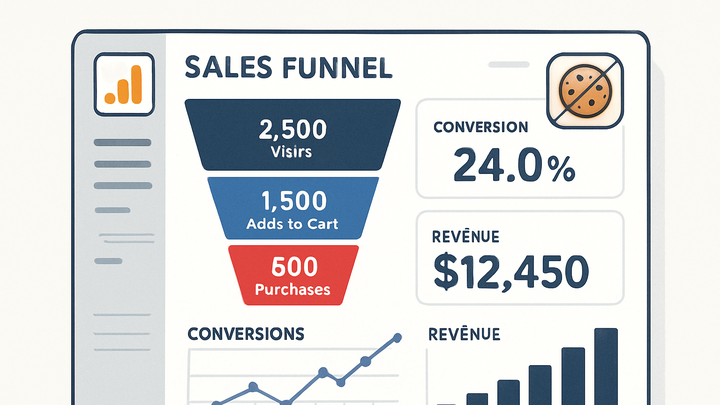Published on 2025-06-28T06:17:00Z
What is E-commerce Tracking? Examples of E-commerce Tracking
E-commerce tracking is the process of collecting and analyzing data on user interactions related to online sales. By instrumenting your website or app to capture events such as product views, add-to-cart actions, and purchases, you gain insights into customer behavior, funnel performance, and revenue drivers. Tools like Google Analytics 4 (GA4) and privacy-focused solutions such as PlainSignal enable tracking across different platforms while balancing user privacy. E-commerce tracking helps businesses optimize marketing spend, improve site usability, and increase conversion rates. Implementing accurate tracking is essential for data-driven decision making and long-term growth.
E-commerce tracking
Monitor and analyze online sales events, user behavior, and revenue with e-commerce tracking in GA4 and PlainSignal.
Why E-commerce Tracking Matters
E-commerce tracking offers valuable insights into how customers interact with your online store, revealing purchasing patterns, customer preferences, and obstacles in the buying journey. By analyzing this data, businesses can refine marketing strategies, optimize product assortments, and improve overall user experience. Without reliable tracking, decisions are based on assumptions rather than evidence, leading to lost revenue opportunities. This section explores the core benefits and business impact of e-commerce tracking.
-
Understand customer behavior
Observe how users navigate product pages, add items to the cart, and complete purchases to identify popular products and common drop-off points.
-
Measure marketing roi
Attribute sales to specific marketing campaigns, channels, and promotions to calculate return on investment and allocate budgets effectively.
Key Metrics in E-commerce Tracking
Tracking specific metrics provides a clear view of your store’s performance and customer engagement. These key indicators help pinpoint strengths and weaknesses in the sales funnel.
-
Conversion rate
The percentage of website visitors who complete a purchase. A higher rate indicates a more effective checkout flow and product appeal.
-
Average order value (aov)
The average amount spent per transaction. Increasing AOV can significantly boost revenue without raising traffic volume.
-
Cart abandonment rate
The proportion of shoppers who add items to their cart but leave before purchasing. Reducing abandonment can lead to higher sales.
-
Revenue per visitor
Total revenue divided by the number of unique visitors, offering insight into how effectively traffic converts into sales.
Implementation with PlainSignal and GA4
E-commerce tracking can be implemented using various analytics platforms. PlainSignal offers a simple, cookie-free setup, while GA4 provides advanced features for in-depth analysis. This section covers setup examples and highlights key considerations for each tool.
-
PlainSignal setup example
Add the following snippet to your website to enable PlainSignal’s cookie-free e-commerce tracking:
<link rel="preconnect" href="//eu.plainsignal.com/" crossorigin /> <script defer data-do="yourwebsitedomain.com" data-id="0GQV1xmtzQQ" data-api="//eu.plainsignal.com" src="//cdn.plainsignal.com/plainsignal-min.js"></script>Once installed, PlainSignal will automatically capture page views, product impressions, and purchase events without relying on cookies.
-
Cookie-free approach
PlainSignal uses privacy-friendly fingerprinting and contextual signals instead of cookies, ensuring compliance and user privacy.
-
Automatic event detection
Transactions and product actions are mapped automatically, reducing manual configuration.
-
-
GA4 setup example
To set up e-commerce tracking in GA4, include the global site tag and configure e-commerce events:
<!-- Global site tag --> <script async src="https://www.googletagmanager.com/gtag/js?id=GA_MEASUREMENT_ID"></script> <script> window.dataLayer = window.dataLayer || []; function gtag(){dataLayer.push(arguments);} gtag('js', new Date()); gtag('config', 'GA_MEASUREMENT_ID'); // Example purchase event gtag('event', 'purchase', { transaction_id: 'T12345', value: 59.99, currency: 'USD', items: [{id: 'P123', name: 'Product Name', quantity: 1, price: 59.99}] }); </script>-
Measurement id configuration
Replace
GA_MEASUREMENT_IDwith your property’s unique ID to begin data collection. -
E-commerce events
Implement standard events such as
view_item,add_to_cart, andpurchasefor comprehensive funnel analysis.
-
Best Practices for Effective E-commerce Tracking
Following best practices ensures accurate data collection and reliable insights. This section outlines recommended strategies and common pitfalls to avoid.
-
Implement a data layer
Use a standardized data layer to structure and push e-commerce data (e.g., transactions, item details) consistently across tags and analytics tools.
-
Ensure data accuracy
Regularly audit your tracking setup to verify that events and values are recorded correctly, avoiding duplicate or missing transactions.
-
Maintain privacy compliance
Adhere to regulations like GDPR and CCPA by anonymizing user data, honoring Do Not Track signals, and providing clear consent mechanisms.
